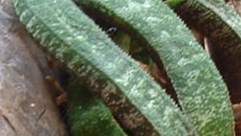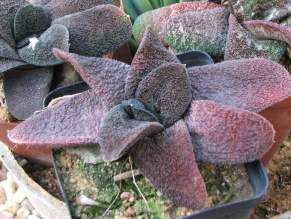Gasteria batesiana
Gasteria batesiana Rowley
Family: Asphodelaceae
Common names: wart-leaf gasteria (Eng.); knoppies-beestong (Afr.); indvololwane (siSwati)
Introduction
Gasteria batesiana is a small charming species bearing rough tuberculata brittle leaves. It is ideal for containers in a shady spot. It is at once recognized by its small rosettes of triangular-lanceolate leaves often with transverse mottled cross bands, simple inflorescence of large nectar-rich flowers attracting sunbirds during spring. The plant soon proliferates from the base forming small groups. Due to its medicinal use it is becoming very rare. Gasteria batesiana is one of 20 Gasteria species mainly confined to South Africa and southern Namibia (1 species).

Description
Description
Plants small and stem-less (acaulescent) up to 100 mm tall and 80-300 mm in diameter, proliferating from the base to form groups, rarely solitary. Its roots are succulent and cylindrical (terete).

The young leaves are initially in two opposite rows (distichous) becoming rosulate, 50-180 X 15-40 mm, of a firm, but brittle texture. The shape is triangular or triangular-lanceolate or rarely linear, they are ascending spreading ultimately becoming recurved. The upper surface becoming channeled during the drought. The lower surface is convex bearing an off-centre keel. Both surfaces are dark green with dense white spots arranged in transverse bands and distinctly densely tuberculate, with larger and smaller green or white tubercles. The juvenile leaves are strap-shaped. The leaf apex is obtuse bearing a mucro.

The inflorescence is a simple ascending spreading raceme (rarely branched) 300-450 mm long. The flower stalk or pedicel is drooping and 9 mm long. The tubular flowers (perianth) are 35-40mm long, the base slightly swollen. The stamens are shortly exserted or protruding. The ovary 7 X 3 mm cylindrical bearing a style of 15 mm in length. The stigma included or becoming shortly exserted. The capsule 16-20 mm long bearing black flattened seed 4-6 mm x 2-3 mm.
Flowering time: October to December
Conservation Status
Status
Gasteria batesiana is becoming threatened due to its medicinal use in KwaZulu-Natal, Swaziland and Mpumalanga. The plants are used as charms to bring good fortune.
Distribution and habitat
Distribution description
Gasteria batesiana has the most northerly distribution in the genus, occurring east of the inland escarpment from north of the Tukhela (Tugela) River in northern KwaZulu-Natal to the Olifants River Valley in the Limpopo Province. It is found in bushveld (savannah) at elevations from 500 to 700 m, in hot, dry, frost free river valleys in mountainous terrain and the plants are mostly confined to cliff faces. Its habitat consists of shady southern and eastern aspects where it occurs in shallow humus-rich soil (pH 6,8 - 7,1).

Forms
The plants in the field are very variable. From Pongola Dam the late Dave Hardy introduced plants bearing long strap-shaped leaves. The cultivated plants have been given the cultivar name 'Pongola'. David Styles from KwaZulu-Natal discovered similar long leafed plants from the Mzimduzi River near the Mkuze Game Reserve bearing almost smooth leaves. The plants introduced into cultivation have been given the cultivar name 'Mzimduzi'.
The most attractive form of Gasteria batesiana originates from Barberton in Mpumalanga, bearing dark almost black-green triangular-lanceolate leaves. In spite of much searching it has not yet been re-located. However it lives on in cultivation.

Gasteria batesiana var. dolomitica has also fairly recently been named as a form. With very brittle almost cylindric leaves, it grows on dolomite cliffs along the Olifants River in Limpopo province. When the longish linear leaves touch the ground, they spontaneously root forming new plantlets. The leaves are beautifully mottled (white, green, and dark grey), almost like a snake.
Gasteria batesiana is related to G. tukhelensis, another cliff dwelling endemic species of the Tukhela River, just south of G. batesiana territory. Gasteria tukhelensis is a much larger species bearing a branched inflorescence, the flowers are also larger with slender long stalks and with smooth shiny leaves.
Derivation of name and historical aspects
History
Gasteria batesiana commemorates Mr. John Bates, a trolley bus conductor in London and a keen collector of South African succulents. It was described by Mr. Gordon Rowley in the National Cactus and Succulent Journal in 1960. Mr. Rowley is a well known succulent author living near Reading, England.
Gasteria batesiana is probably one of the most popular Gasteria species due to its ease of cultivation and ornamental appearance. It was first collected in May 1924 by Mr Frank Frith, first horticulturist of the South African Railways, a keen plantsman, succulent collector and explorer who might have been responsible for its introduction to Europe. Although it had been in cultivation in Europe and in South Africa since the early part of the previous century its location in the natural habitat remained unknown until 1958 when Mr Theo Sprengel of Igogo Natal collected living specimens near Piet Retief in Mpumalanga and brought them to Mr Harry Hall at Kirstenbosch. Fortunately today, many sites in northern KwaZulu-Natal are known.
Ecology
Ecology
Gasteria batesiana is pollinated by sunbirds. Its fruiting capsules becoming erect after fertilization, opening from the top only to release its flattish seed by gusts of wind, thus ensuring a sufficient dispersal distance. Its fleshy leaves store water making it a drought tolerant and ideal water wise garden plant. In spite of its habitat on cliffs becoming bone dry during winter, the plants have enough water supply for survival.
Uses
Use
Gasterias are popular among traditional healers. These plants are believed to have the magical power of transferring their camouflage properties, which are provided by their mottled leaves that blend in well with surrounding vegetation, to humans who wash with the leaves.
Growing Gasteria batesiana
Grow
Gasteria batesiana is easily propagated from leaf cuttings or seed. It is a slow growing but long-lived species. To grow from leaf cutting, remove leaves and allow the leaves to dry and heal on a cool window sill for at least 3 weeks. Treat the basal part with a fungicide. Plant the leaves erect or lying on their side in sandy soil. Rooting is rapid and young plants can be harvested the following season.
Seed should be sown during summer in sandy, well-drained soil and preferably protected from full sun. The seedlings are slow growing and can be planted out in small containers when they are large enough to handle. The soil should preferably be enriched with compost. They react very well to a liquid organic fertilizer.
References
- Van Jaarsveld, E.J. 1994. Gasterias of South Africa. Fernwood Press.
- Van Jaarsveld, E. J. and van Wyk, A. E. 2005. Gasteria tukhelensis: a new species from KwaZulu - Natal, South Africa. Bothalia 35(2)164-166.
Credits
Ernst van Jaarsveld
Kirstenboch National Botanical Garden
March 2006
Plant Attributes:
Plant Type: Succulent
SA Distribution: KwaZulu-Natal, Limpopo, Mpumalanga
Soil type: Sandy, Loam
Flowering season: Spring
PH: Acid, Neutral
Flower colour: Pink
Aspect: Shade, Morning Sun (Semi Shade)
Gardening skill: Easy
Special Features:
Horticultural zones








Rate this article
Article well written and informative
Rate this plant
Is this an interesting plant?
Login to add your Comment
Back to topNot registered yet? Click here to register.